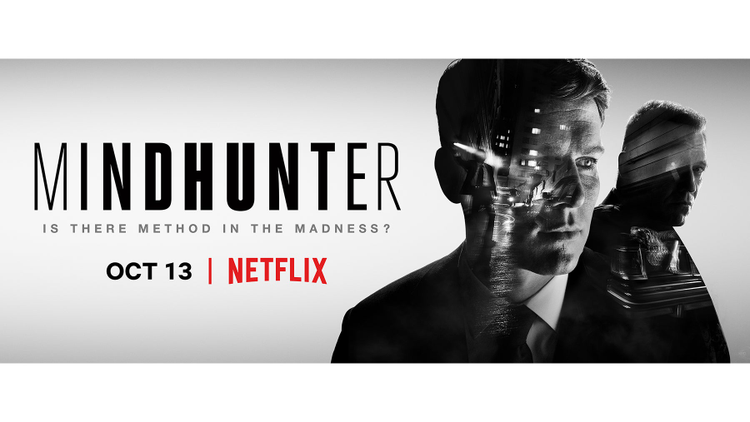Netflix Series MINDHUNTER Brings Filmmaking Savvy to Episodic TV

David Fincher is known for directing many successful films, including Gone Girl, The Social Network, The Girl with the Dragon Tattoo, and The Curious Case of Benjamin Button, as well as the Netflix hit series House of Cards. With each new project, he mesmerizes audiences with his unique storytelling and visual style. His latest project, the 10-episode Netflix series MINDHUNTER, is no exception.
One of the keys to David Fincher’s success is a talented post-production team that shares his work ethic, passion for filmmaking, and willingness to push boundaries. Peter Mavromates has served as a producer and post-production supervisor on multiple Fincher projects, while Editors Kirk Baxter and Tyler Nelson, along with Assistant Editor Billy Peake and In-house VFX Compositor Christopher Doulgeris, are all veterans on the team.
After developing and refining its post-production workflow on other projects, the team pushed it even further on MINDHUNTER, a series that follows a group of FBI agents in the 1970s who set out to uncover the psychology behind serial killers. The underlying obsession of FBI agents to uncover the makings of a murderer bears a striking resemblance to the editorial team’s preoccupation with achieving filmmaking perfection.
“As editors, we are very similar to the FBI characters,” says Byron Smith, one of the editors. “We are like investigators obsessing over footage to bring out the best in every detail to make each shot as enriched as possible.”
This work ethic trickles down from David himself. “Working with David is great because he’s extremely detail-oriented and he understands how visual effects work,” explains Christopher Doulgeris. “When he gives you a production note, it’s a note that is truly informed.”
Fincher shot the entire 10-hours of content in 6K, which presented the team with both new challenges and opportunities. The team used automated scripting in Adobe Premiere Pro to transform dailies from the set in Pittsburgh, Pennsylvania into fully prepped dailies projects overnight for the editors in Los Angeles, California.
“David could see selects and assemblies the day after shooting, helping him quickly identify what was working and what wasn’t,” says Billy Peake. “If a scene was shot over two days, we had the dailies from the first day organized and ready on the second day to help him set up the next part of the scene.”
Shooting in 6K for a 5K extraction also gave David and his post-production team the freedom and room to reframe shots as needed. This approach enables them to move a shot left, right, up, or down in post-production without destroying the original framing or impacting the intent of the DP.
“Rather than punching in and losing content, we can fine-tune the way a scene looks or the way two shots play together while remaining faithful to the original shot,” says Billy.
As editors were cutting scenes, if they decided that the rhythm of the dialog between actors should fall into a different cadence they used split-screening. Making a cut down the middle of a shot let them speed up or slow down the timing of the dialog between actors.
The team also stabilized shots to smooth out the motion and create a unique visual tone. While some basic compositions were achieved in Premiere Pro, the team enhanced approximately 90% of shots with Adobe After Effects, with assistant editors using Dynamic Link between Premiere Pro and After Effects to create the temporary offline VFX.
With this project, the team challenged themselves by adding color correction to their post-production pipeline to give the series its unique periodic finish. The colorist added artificial lens distortion, pulling corners of the image in to create a warped, anamorphic squeeze and adding distortion and chromatic aberration to give the illusion that it was shot with vintage lenses.
“We try to do something new and different every time we work with David,” says Tyler Nelson. “Cutting rooms these days try to make an offline edit look as close to the finished product as possible by integrating visual effects, sound, and color into what is ultimately in the hands of the editor.”
By bringing VFX in-house, and even creating digital intermediates using turnovers from Premiere Pro, the team minimized its reliance on outside agencies. Not only did this give them more control over the final content, but it also aligned with their goal of speeding up production. Once editorial turned over a visual effect shot to Christopher, he could do his work, render it, and deliver it back to editorial within a few hours, versus a couple of days if it had been sent to an external vendor.
“I was able to work on many different shots at the same time and easily go back and forth between them, which is important for continuity as well as productivity,” says Christopher. “It’s helpful for all of us to be using the same tools. It’s like we’re all speaking the same language.”
Having everything needed for production under the same roof also has other advantages. “It’s great to have a compositor right down the hall to bounce ideas off of, especially when we’re working within a tight timeline,” says Tyler. “I could ask Christopher for his opinion, and know with confidence that any edit I made wouldn’t drastically impact someone else’s job downstream.”
The team’s meticulous work ethic, combined with Adobe’s industry-leading editing and visual effects tools, are sure to come through in the final product. Season one of MINDHUNTER released on Netflix on October 13, 2017.
Learn more about Adobe Creative Cloud pro video tools